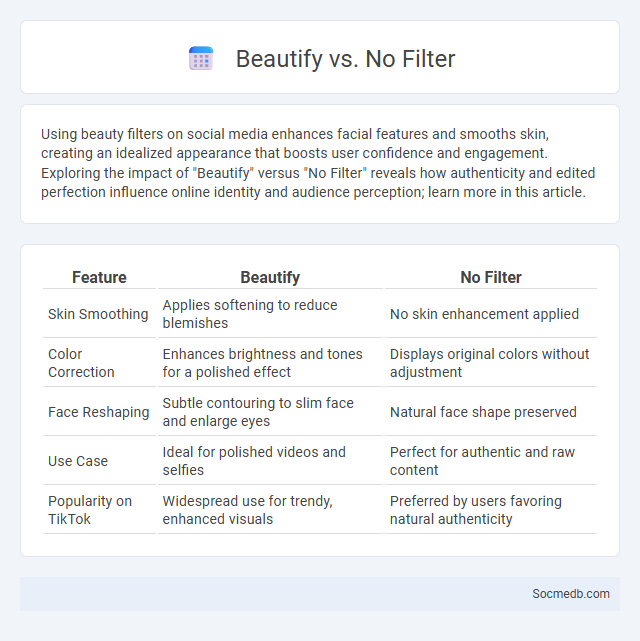
Photo illustration: Beautify vs No Filter
Using beauty filters on social media enhances facial features and smooths skin, creating an idealized appearance that boosts user confidence and engagement. Exploring the impact of "Beautify" versus "No Filter" reveals how authenticity and edited perfection influence online identity and audience perception; learn more in this article.
Table of Comparison
| Feature | Beautify | No Filter |
|---|---|---|
| Skin Smoothing | Applies softening to reduce blemishes | No skin enhancement applied |
| Color Correction | Enhances brightness and tones for a polished effect | Displays original colors without adjustment |
| Face Reshaping | Subtle contouring to slim face and enlarge eyes | Natural face shape preserved |
| Use Case | Ideal for polished videos and selfies | Perfect for authentic and raw content |
| Popularity on TikTok | Widespread use for trendy, enhanced visuals | Preferred by users favoring natural authenticity |
Understanding Beautify, No Filter, and Filter: Key Differences
Understanding "Beautify," "No Filter," and "Filter" on social media involves recognizing their distinct impacts on image presentation and user perception. "Beautify" features use AI to enhance facial features more naturally, while "Filters" apply broader stylistic changes like color shifts and textures, often altering the entire image's mood. "No Filter" signifies authentic, unedited photos, promoting transparency but sometimes facing scrutiny for imperfections in the visually-driven social media environment.
How Beautify Tools Transform Your Photos
Beautify tools enhance your photos by smoothing skin, brightening eyes, and adjusting facial features to create a polished, professional appearance. These advanced algorithms analyze lighting, texture, and color balance to automatically correct imperfections and highlight your best traits. Using beautify tools on social media platforms maximizes engagement by presenting visually appealing images that capture attention quickly.
The No Filter Movement: Embracing Authenticity
The No Filter Movement celebrates raw, unedited social media content that emphasizes authenticity over perfection, fostering genuine connections among users. Influencers and everyday users alike share real-life moments, promoting self-acceptance and mental health awareness. This shift challenges traditional beauty standards and encourages transparency in digital interactions.
Exploring Filter Effects: From Subtle to Dramatic
Filter effects on social media platforms transform images and videos by enhancing colors, adjusting lighting, and altering textures to create visually compelling content. These effects range from subtle enhancements that maintain natural looks to dramatic transformations that completely change the mood and style, influencing audience engagement and perception. Popular filters on Instagram, Snapchat, and TikTok utilize AI algorithms to deliver creative options that cater to different aesthetic preferences and storytelling needs.
Psychological Impact of Filters and Beautify Features
Social media filters and beautify features significantly influence users' self-perception by creating unrealistic beauty standards and promoting comparison-driven anxiety. These digital enhancements can lead to decreased self-esteem, body dysmorphia, and a distorted sense of identity, particularly among teenagers and young adults. Research indicates that prolonged exposure to filtered images correlates with increased symptoms of depression and social withdrawal, highlighting the need for awareness and balanced usage.
Social Media Trends: Beautify vs. Filter vs. No Filter
Social media trends reveal a growing divide between beautify filters, heavy editing tools, and the emerging preference for no-filter authenticity. Platforms like Instagram and TikTok show increased engagement on posts showcasing natural, unfiltered appearances, reflecting shifting user values toward transparency and self-acceptance. AI-driven beautify filters remain popular for enhancing features, but consumer demand steadily pushes creators to balance enhancement with genuine representation.
Pros and Cons: Beautify, No Filter, and Filter Approaches
Social media platforms offer the ability to beautify images, enhancing your appearance to create polished and eye-catching posts that boost confidence and engagement. No filter approaches highlight authenticity and raw beauty, fostering genuine connections but may expose imperfections that affect self-esteem. Filter methods balance creativity and realism, allowing personal expression while sometimes promoting unrealistic beauty standards that influence mental health.
Influencer Perspectives on Editing Photos
Influencer perspectives on editing photos reveal a strategic balance between authenticity and aesthetic appeal to engage followers effectively. Your editing choices can enhance visual storytelling, boosting brand image and audience connection through carefully curated content. Embracing subtle enhancements instead of heavy filters often fosters trust and relatability within the influencer community.
Ethics and Transparency in Photo Enhancement
Ethics and transparency in photo enhancement on social media are crucial for maintaining trust and authenticity among users. Clear disclosure of edited images prevents misleading representations and supports honest communication, especially in advertising and influencer marketing. Platforms that enforce guidelines on photo modifications help foster a responsible digital environment and protect vulnerable audiences from unrealistic beauty standards.
Choosing the Right Approach for Your Online Image
Selecting the right approach for your online image involves understanding your target audience and tailoring your social media content to resonate authentically with their interests and values. Consistent branding across platforms like Instagram, LinkedIn, and Twitter enhances your visibility and credibility, while strategic engagement through regular posts, interactive stories, and timely responses builds a loyal community around your digital presence. You can boost your social influence by analyzing platform-specific algorithms and optimizing content formats, ensuring maximum reach and impact.
 socmedb.com
socmedb.com